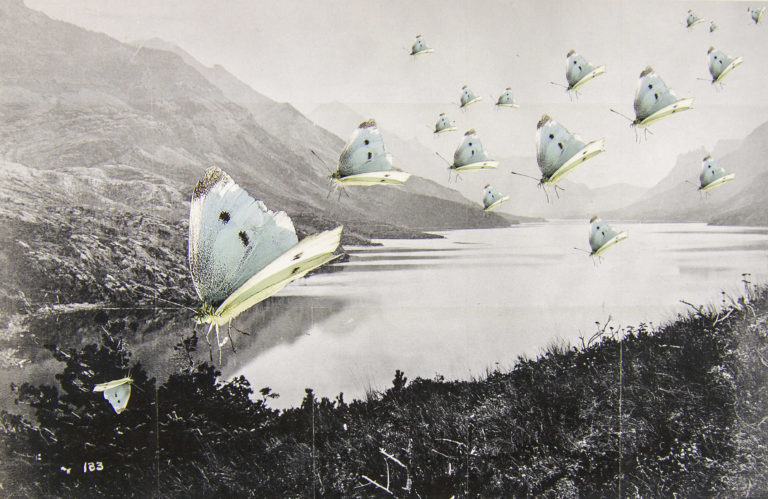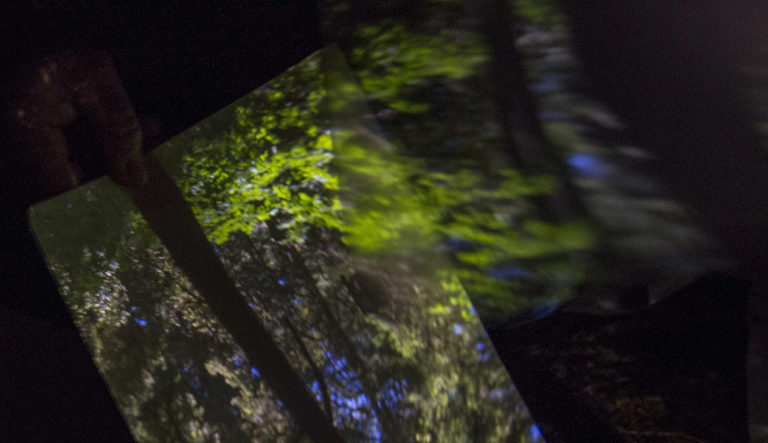Conduit
Collaboration with artist Jamie Drouin.
Conduit:Roundhouse
A video shows Smith sitting on a chair, documenting the surrounds with a small wooden camera – a swing-lens Kodak Panoram from the early 20th century. The artist modified the camera, breaking it, disengaging the mechanical shutter, so it works by moving the swinging action of the lens by pulling at threads wrapped around her fingers.
Conduit:Roundhouse is a collaborative project between artists Jamie Drouin and Trudi Lynn Smith. A series of works, developed through visits to the E&N Roundhouse in Victoria West, operate at the interdisciplinary fold of visual and sound art.
Background
The E&N Roundhouse is located on stolen Indigenous land. The City of Victoria and the surrounding areas lie on the territories of the Lekwungen and Coast Salish peoples, and the E&N site lies on the territories of the Esquimalt and Songhees peoples. Within the colonial state, it is considered an important part of the architectural history of Canada evidenced by several prominent designations including its classification as a National Historic Site by the Government of Canada and a Municipal Heritage Property from the City of Victoria. It is slated for re-development.
At present a site of transition, over the course of the last few years, the Roundhouse has been a progressively fleeting space, no longer a working train yard.
The Artworks
The radical reformulation of movement, vision and travel that was generated by the locomotion of the railway was of considerable interest for Smith. During that time, a profusion of new technology experimented with an emerging individuality. These 19th century technologies – ranging from optical devices, sensorium environments and film, were on the edge of possibility in the colonial industrial machine. The radical reformulation of the world – and the consequences – bear consideration.
Finger camera: A video shows Smith sitting on a chair, documenting the surrounds with a small wooden camera – a swing-lens Kodak Panoram from the early 1910s, one that would have been used during the heyday of the roundhouse and rail (figure 1). The artist modified the camera, disengaging the mechanical shutter, and moving the swinging action of the lens by hand. The camera works not by mechanical shutter but by the user wrapping string around their fingers and pulling the shutter as it is wrapped. The video does not show the photographic documents the camera produced, instead, the impossibility of the viewer seeing the thing that the photographer documents is at the heart of this piece. Not content to create new archival footage of a changing space, the artist challenges both the documentary ‘evidence’ of the archive and also makes evident the radical subjectivities and relations at the heart of photography.
Drouin presents two sculptures which function as echoes of the physical structure. The first isolates and replicates the recessed corridors originally used by maintenance teams to access the underside of the train cars. In Drouin’s large-scale sculpture these corridors are illustrated by two parallel lines of blackened thin metal plates in an otherwise featureless room, terminating at one wall, and then reflected by mirrors.
Drouin’s second sculpture focuses on the low frequency sound collected by the Roundhouse structure. A large subwoofer cabinet speaker sits in the center of a room with a solitary flashlight resting on its top. Pre-recorded ultra low frequency sounds (ULF) collected at the Roundhouse – seismic activity, outside traffic from the nearby road, and construction work by the property developers – are barely audible to the ear, but vibrate both the speaker, and the flashlight, creating a subtly animated circular projection of light on one wall.







